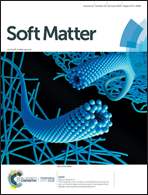The influence of pH, protein concentration and calcium ratio on the formation and structure of nanotubes from partially hydrolyzed bovine α-lactalbumin†
Abstract
Formation of nanotubes from partially hydrolysed α-lactalbumin (α-La) was investigated at five pH values, two concentrations of α-La and two calcium levels. Nanotubes were formed under almost all combinations of the investigated factors, and for the first time the formation of nanotubes at low pH (4.0) and low protein concentration (10 g l−1) was observed. Only one sample (10 g l−1, calcium ratio 2.4, and pH 7.5) formed mainly fibrils instead of nanotubes. By altering the three investigated factors, fibrils and/or aggregates were sometimes formed together with nanotubes resulting in transparent, semi-transparent, or non-transparent gels, or sediments. However, structural modelling based on small-angle X-ray scattering data indicated that the formed nanotubes were only to a minor degree affected by the investigated factors. The majority of the nanotubes were found to have an outer diameter of around 19 nm, an inner diameter of 6.6 nm and a wall thickness of 6.0 nm, except for three samples at low α-La concentrations and high calcium levels which exhibited slightly smaller dimensions. These three factors affected the hydrolysis as well as the self-assembly rate, resulting in the observed differences. However, these factors did not influence the architecture of the self-assembled nanotubes, and the lateral spacing of the individual parallel β-sheet motifs was found to be 1.05 ± 0. 03 nm for all nanotubes. This study provides novel fundamental knowledge of the formation and structure of α-La nanotubes under different conditions, which will facilitate future application of these nanotubes in food and pharmaceutical areas.



 Please wait while we load your content...
Please wait while we load your content...